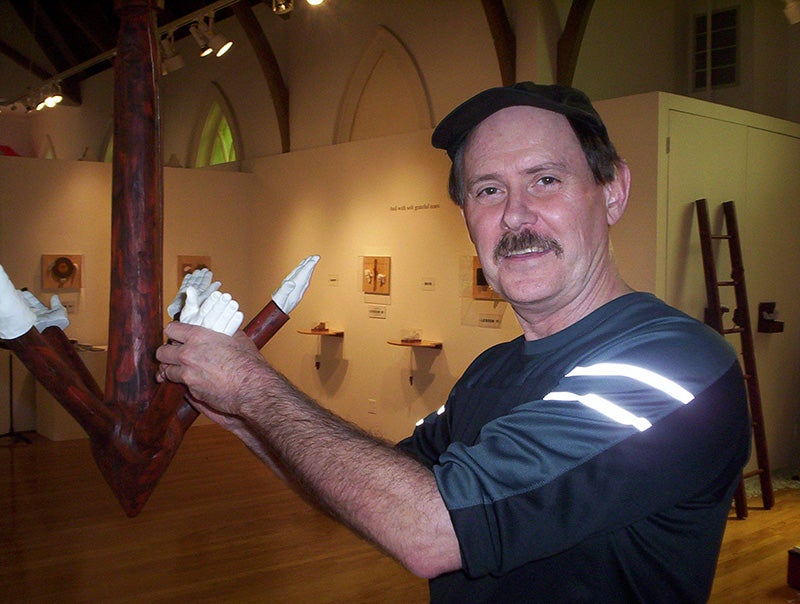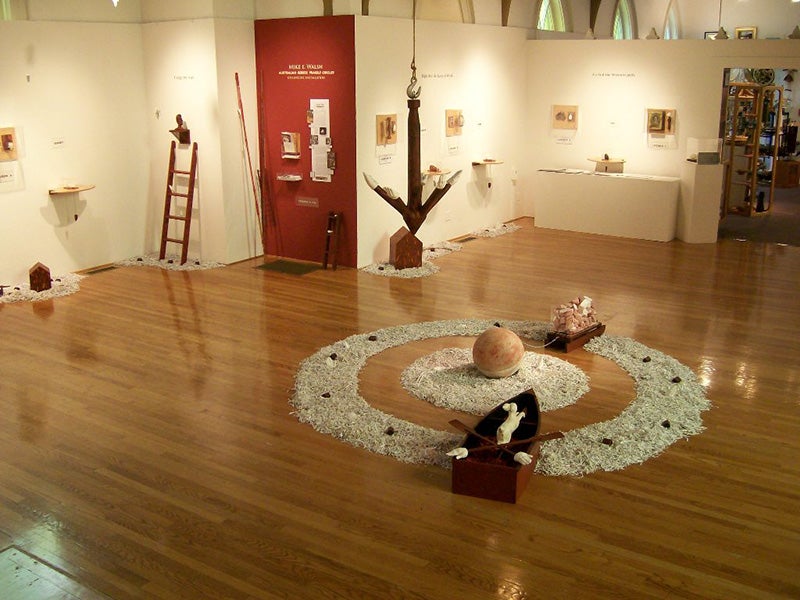Michael E. Walsh, bachelor of fine arts ‘72
Vietnam tour, travel in Asia influenced Walsh’s socially conscious art
Michael E. Walsh was on track to teach English as a second language in Kenya on a Peace Corps mission when the Vietnam War took his career on an unexpected detour in 1966. He was at Columbia University, training for the Peace Corps at the Institute for Education in Africa, Teachers College, when his draft number came up.

Above: Michael Walsh assembling an art installation at The Arts Center in Corvallis, Oregon. Photograph courtesy Michael Walsh.
Walsh opted to join the Navy and spent four years on two different destroyers, one based in Long Beach, California, and the other in Japan. While in Asia he was able to travel in Japan, even climbing Mt. Fuji, but often made the journey south to Vietnam for 90-day missions aboard ship, where he faced attacks from Viet Cong gun emplacements and other combat dangers.
In summer 1967, he was serving aboard the destroyer USS Rupertus, which was on duty with the aircraft carrier USS Forrestal in the Gulf of Tonkin. Leaking aviation fuel set off an explosion aboard the carrier; as “phone talker” for the captain on the Rupertus bridge, Walsh relayed orders as sailors pushed aircraft into the sea and several men jumped overboard to escape flames. The fire eventually killed more than 130; survivors include now-Senator John McCain.
The warships on which Walsh served also brought him to many ports of developing countries, including the Philippines, Singapore, Malaysia, and Taiwan.
“It was my first introduction to mass poverty, which sensitized me to the plight of my fellow man—a major influence on my socially conservative art practice,” he said.
Even while in the military, Walsh planned to come back to Oregon and work as an artist. So he studied art and art history through reading, visiting libraries, and attending art exhibitions in the Los Angeles and Tokyo areas.
“It probably took me longer to become an artist because I didn’t come back from Vietnam until my late twenties, so I really didn’t study art as intensively as I wanted to,” said Walsh.

Above: Walsh emulated the iconic aboriginal "dreaming circle" using shredded paper, boats, and cast plaster rabbit heads to symbolize Occidental Arrival. "Rabbits are not native to Australia and were introduced by whites; they have played havoc in the natural environment," says Walsh. The "Australian Series" site-specific solo installation "Lesson Plan" was displayed in 2007 at the Arts Center in Corvallis, Oregon."
After the Navy, Walsh studied studio art at UO from 1970 to 1972, working with fiber under instructor Max Nixon, the former head of the metalsmithing and jewelry program. He also studied printmaking under Laverne Krause and painting with Frank Okada.
His final art project in 1972 at UO was a site-specific installation called “Capacity,” which consisted of strands of jute and sisal rope filling Gallery 141 in Lawrence Hall. “If you came into the installation, you could manipulate the ropes,” Walsh said. “It was pretty innovative for its time.”
He spent a term as a student art teacher at North Eugene High School, although he felt he spent more time on discipline than artistic pursuits. “All the students seemed to be placed in that program because they couldn’t handle them anyplace else,” he said. “It didn’t seem very rewarding to me as a teacher.”
Walsh now lives in Eugene and regularly exhibits his art around the world while remaining involved in the local art community. He became a Northwest contributing editor for the Bay Area-based art magazine Artweek, worked for several local galleries, and founded three Eugene art institutions: the New Zone Gallery, Open Gallery, and Project Space, the latter two of which are now closed. He also served on the board of directors for the Jordan Schnitzer Museum of Art and the Maude Kerns Art Center.
His family has longtime roots in the south Willamette Valley. Two of his great-great grandfathers crossed the Oregon Trail and settled twenty miles north of Eugene near Monroe. Ingram Island on the Willamette River was named for his ancestor James Wilson Ingram.
“That’s why so much of my work deals with history or historical events. I’m also my family historian,” said Walsh, who was born in Dallas, Oregon.
His finished projects have been displayed in more than 400 group and solo exhibitions. His mixed-media works are included in more than twenty permanent collections, including the Museum of Art and Design in New York, the Kaohsiung Museum of Art in Taiwan, the Portland Art Museum, and the Jordan Schnitzer Museum of Art in Eugene.

Above: Walsh's "Australian Series" was inspired in part by the prejudices faced by Australian folk singer Archie Roach (pictured).
During the 1980s, Walsh lost many of his friends to AIDS. In response, he created two installations, including “Structuring Fear: Remembering” (2005), which was exhibited at the Downtown Initiative for the Visual Arts Center in Eugene. For this commemorative exhibit, forty-six vertical window blind slats hung from the ceiling, each designated with the name of a deceased Oregon artist. Bowls of evaporating red liquid sat on the floor beneath each blind slat.
Politics, religion, cultural traditions, and international travel have inspired him throughout his artistic career. His travels have also informed his work exploring racial prejudice. He encountered discrimination against people of mixed race during a 1999 trip to Australia, which inspired his exhibit, “Australia Series.” This series, finished in 2006, plays on the theme of the continent’s relationship with prejudice in the modern era.
In Australia, he said, “if you [were] half-aboriginal and half-white, the state took your children away … and tried to raise them in white families. They had this form of racism until 1974.”
For a 2014 project, “India Series: An Unexpected Journey,” Walsh addressed societal issues through structures, handmade from plaster, paper, and found objects situated inside Plexiglas boxes.
“[‘India Series’] conveys turmoil in all countries,” Walsh said of the exhibit, which was at the Jacobs Gallery at the Hult Center in Eugene. “Not just there, even here. Most people don’t think about this, walking down the street. Most people just [travel abroad] for the experience and don’t delve into the politics or anything historical.”
A recurring visual in the series is the playing grid from the board game “Snakes and Ladders.” The game was created in India in the 16th century and later reincarnated as “Chutes and Ladders” by Milton Bradley in the United States. Walsh looked for a copy of the board game in Jaipur, India, during a 2009 trip to the country, an excursion that ultimately inspired the series.

Above: Walsh's piece "Varanasi," on exhibit at the Jacobs Gallery at the Hult Center in Eugene in 2014, was inspired by witnessing human cremations on the Ganges River during his India trip in 2009. Photograph courtesy Michael Walsh.
Its visual symbolism plays on the highs, lows, and general instability of India’s past. Each piece in “India Series” represents a political event or a different city. In “Varanasi,” Walsh recounts witnessing the burning ghats, or open-air human cremations, on the Ganges River. The artwork shows a burning house-shaped structure, symbolic of the ritual.
The exhibit also included “Indus,” which is comprised of three glass display cases. One is filled with salt, another has water from the Ganges, and the third has the “Snakes and Ladders” design. This was inspired by Gandhi’s hope for abolition of the salt tax imposed by the British Empire.
“Gandhi marched from Ahmedabad to the sea on the west coast to the sea at Dandi. They boiled their own seawater and let it evaporate,” he said. “Gandhi was trying to demonstrate an issue that’s been there for hundreds of years.”
Shreds of paper, representing disbanded treaties and torn documents, surround the Plexiglas vitrines. A white hand made from plaster holds down the vitrine containing rock salt, which Walsh says represents Occidental control over the salt tax.
In “Cawnpore Massacre,” Walsh pays reverence to the historical massacre by East India Company Troops in 1857 near present-day Kanpur. In “Deception,” Walsh was intrigued by India military’s nuclear weapons, despite being a country plagued with poverty.
“[India’s military] seem that they aren’t as dangerous as Pakistan having nuclear weapons, but it’s totally out of sync in some ways,” he said.
His commentary on everything from Mahatma Gandhi’s advocacy against the British Empire to the Indian government’s nuclear warheads is voiced in his artwork.
“It’s influenced by my travel,” he said. “It continues my interest in the many injustices of different countries [and] the different rituals associated with those cultures.”
